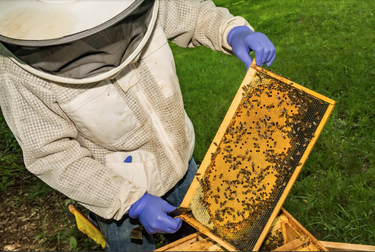State comes up with more ways to protect pollinators
— Photo from the New York State Pollinator Protection Plan Update
New state recommendations for protecting pollinators include creating the Cooperative Honey Bee Health Improvement Plan, expanding the state’s Beekeeper Tech Team, increasing pollinator-friendly habitats, and continuing research on the major stressors to honey bees.
New York State’s plan to protect pollinators has been updated.
The state’s departments of Agriculture and Markets; Environmental Conservation; and Office of Parks, Recreation and Historic Preservation have updated the plan, first launched in 2016.
New recommendations include creating the Cooperative Honey Bee Health Improvement Plan, expanding the state’s Beekeeper Tech Team, increasing pollinator-friendly habitats, and continuing research on the major stressors to honey bees.
According to the United States Department of Agriculture, pollinators provide approximately $344 million worth of pollination services to New York and add $29 billion in value to crop production nationally each year. New York’s ability to produce crops such as apples, grapes, cherries, onions, pumpkins, and cauliflower relies heavily on the presence of pollinators.
The Pollinator Protection Plan has helped advance many of the state’s goals to protect its pollinator populations, including developing voluntary best management practices for all pollinator stakeholders and developing habitat enhancement efforts to protect and revive populations of native and managed pollinators, according to a release from the governor’s office.
State agencies have contributed to enhancing habitats and implementing best management practices for pollinators since 2016. Agencies have conducted pollinator surveys; reduced or altered mowing practices to avoid disruptions to pollinator life cycles, provide late-season forage and aid in wildflower seed dispersal; planted pollinator friendly trees and flowers in landscaping; installed bee boxes in viable areas; implemented 11 projects that enhanced native pollinator habitat; and educated the public on the diversity and importance of native pollinators.
The Pollinator Plan Update recommends that all state agencies, including the parks department, continue to conserve, maintain, and expand pollinator gardens and larger pollinator habitats, emphasizing the use of native plantings.
The Apiary Inspection Program, housed at the state’s Department of Agriculture and Markets, focuses on the inspection of commercial migratory beekeepers and general inspections to ensure the health of New York’s honey bee population.
To help the Apiary Inspection Program document and manage the incidence of parasites, disease, and other pollinator health threats, legislation has been developed to implement a Cooperative Honey Bee Health Improvement Program.
This would provide information on the annual population of managed pollinators in each county within New York State, allowing for better communication with beekeepers on honey bee health to aid in research and development of best management practices.
In response to rising concerns about honey-bee declines, the plan included the development and expansion of the NYS Beekeeper Tech Team at Cornell University, which works directly with beekeepers to improve honey-bee health, reduce colony losses, and increase profitability of the beekeeping industry.
To date, the tech team has worked with a total of 58 beekeepers who manage 27,094 colonies in New York State. The team has sampled colonies from 138 apiaries across 30 counties to assess the queen status, population strength, brood health, and to collect Varroa, Nosema, and pesticide samples.
The Pollinator Protection Plan Update recommends expanding the tech team by increasing its geographic range to enroll beekeepers in unrepresented areas, such as the North Country, Hudson Valley, New York City, and Long Island. It also recommends the tech team program broaden its reach to New York State beekeepers by offering web-based learning tutorials on best management practices.
Additional future recommendations include targeting Cornell University’s Integrated Pest Management Program to develop best management practices for the use of treated seed in crop production and fungicides in specialty crops. In addition, the update recommends replicating Cornell’s on-farm research on pesticide spray practices and pesticide residues, like pollen and wax, used on strawberry and apple farms to other New York cropping systems and commodities.
The update also supports additional IPM research on alternative control measures and treatment for the Varroa mite. Varroa mites were identified by the tech team as one of the top stressors for honey bees and are a significant predictor of winter colony loss.
The tech team’s 2018 and 2019 annual reports showed that since the launch of the program in 2016, there has been significant improvements in Varroa mite management and honey-bee colony health. The 2019 report indicates that annual colony loss rates had decreased again compared to the prior year. Total colony losses from participating beekeepers was 51 percent in 2016/2017; was 40.5 percent in 2017/2018; and in 2018/2019, that number dropped to 38 percent.
— Melissa Hale-Spencer

